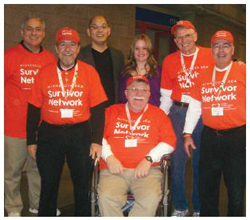Communities outside of Seattle and King County also have noteworthy approaches to CPR training. Some use marketing messages to encourage prompt action. Others use cardiac arrest survivors to facilitate CPR training classes.
Arizona SHARE Bystander CPR Initiative
The Arizona SHARE (Save Hearts in Arizona Registry & Education) Program promotes a comprehensive, standardized system of out-of-hospital cardiac arrest care throughout Arizona encompassing all “links” in the “chain of survival”—bystander response, emergency medical dispatcher CPR instruction, Emergency Medical Services provider resuscitation, and standardized care at hospitals.
The AZ SHARE website offers a large number of resources and tools targeted for SCA survivors, the general public, and other groups (businesses, schools, hospitals) that can be used to improve awareness of SCA and to encourage bystander CPR training.
Since 2005, the SHARE program focused on raising bystander CPR rates. It was the first program to train lay persons to deliver compression-only CPR. By using a variety of methods, the Arizona SHARE program reached over 500,000 individuals in the state through training classes, video viewing, and other marketing methods.
Audio and video messages promoting bystander CPR include a one-minute podcast that discusses the rationale for using compression-only CPR. Available YouTube videos include a six-minute video on compression-only CPR and a five-minute video showing how to use an AED. Visit www.azshare.gov for links to YouTube videos.
The SHARE program tracked the bystander CPR rates across the state. The multiple efforts paid off. Bystander CPR increased from 28% of cardiac arrests in 2005 to 40% in 2009. The increase in bystander CPR was associated with increased survival, as well.12
Chest Compression-Only CPR Campaign in Arizona
-
Website (www.azshare.gov)
-
Brief online video training
-
In-person, free training in many locations throughout the state, primarily sponsored by fire departments
-
Free training kits sent to schools with 6th – 12th grades—students were encouraged to teach family members
-
Public service announcements made by the Governor and local sports celebrities
-
Inserts mailed in utility bills
-
Tables at health and safety fairs by Boy Scouts, fire departments, schools, etc.
-
Newspaper articles and editorials
-
Training video looped on public access cable channels
-
Summer youth classes taught by youth corps volunteers
-
Local radio spots and interviews
-
Special features on local and national TV
-
Frequent email updates distributed to stakeholders
Minnesota Bystander CPR Training
Using the American Heart Association’s Family and Friends CPR Anytime® Kit, the Minnesota SCA Survivor Network conducts school and community CPR and AED training throughout the state. When there is a need for a bystander CPR class, the survivors travel to the location to teach the class. The survivors are a dedicated group of volunteers that spend hundreds of hours every year making sure citizens of Minnesota are trained. Because the survivors tell their stories, learning CPR has a memorable impact on the participants.
 SCA survivors and their families help to increase public awareness of SCA as well as to provide CPR training for bystanders. The Minnesota survivors are among the most active advocates of CPR training and SCA awareness in any area of the country.
SCA survivors and their families help to increase public awareness of SCA as well as to provide CPR training for bystanders. The Minnesota survivors are among the most active advocates of CPR training and SCA awareness in any area of the country.
Survivors wear bright orange Survivor t-shirts when teaching CPR classes and pulling wheeled duffle bags embroidered with the MN SCA Survivor Network logo. The MN survivors have 10-15 CPR manikins in each bag, along with a DVD player and AED trainer.

